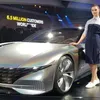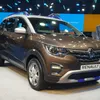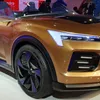Here are the biggest misses of Auto Expo 2020
Followed by a very slow 2019 for the automotive industry, Auto Expo 2020 saw a drop in footfall from 6.6 lakh visitors in 2018 to 6.08 lakh visitors.
The Auto Expo 2020 was missed by several bigwigs, including Toyota, BMW, Bajaj, Royal Enfield, Honda, Hero, and TVS. Chinese manufacturers like MG Motor, Great Wall, and Haima were instrumental in keeping up the sheen with Tata, Mahindra, Hyundai, and Maruti.
While the event saw plenty of action, it did leave us wishing for more. Here are some of the biggest misses from Auto Expo 2020.
Hyundai Verna

The mid-size sedan Hyundai Verna is on schedule to get an update and was expected to be the highlight of the South Korean carmaker’s stall this year. While India was expected to see the new version before any other market, it was finally showcased this week as the Hyundai Solaris in Russia.
Keeping up with the trend, the new Hyundai Verna will get a sharper front grille with bigger LED headlamps at its end. The front bumper is significantly more muscular and has triangular fog-lamp housing, similar to the new Elantra. The registration plate will now be housed in the middle of the cascading grille. Besides that, the new Verna is shod with new alloy wheels. Also, the rear profile gets a new bumper, LED taillamps, and a faux diffuser.
Interiors carry forward the same multifunctional steering wheel and driver instrument console. The dashboard has been slightly tweaked and given a new, 8.0-inch floating touchscreen infotainment system. The new Verna will also be fitted with Hyundai’s Bluelink telematics system and electrically adjustable driver seat.
Powertrain options will include the 1.5-litre petrol and 1.5-litre diesel mills, similar to the Kia Seltos. These engines will also make its way to the new Creta. Gearbox options will include a six-speed manual and a seven-speed dual-clutch automatic.
Renault HBC

The French carmaker was expected to showcase its upcoming sub-four-metre SUV at the Auto Expo 2020. Codenamed HBC, the new compact SUV is expected to be based on the same Kwid-Triber platform. However, the Renault showcased the electric car Zoe, an automatic version of the Triber, the electric Kwid (KZ-E), and a few international concept models.
The Renault HBC will carry design elements from the Triber and Kwid. This will include the same layout of LED daytime running light on top, which is considered as the conventional housing for headlamps.
Besides that, the HBC will be fitted with an all-digital LED driver instrumentation and an 8.0-inch infotainment system. The latter will be compatible with Apple CarPlay and Android Auto. Other features will include push-button start with keyless entry.
Powertrain options will include the 1.0-litre turbocharged petrol engine, which is capable of producing 100 PS of power and 160 Nm of torque. Gearbox options will initially include a six-speed manual and possibly an AMT (automated manual transmission) unit at a later date.
When launched, the Renault HBC will compete against the likes of Maruti Vitara Brezza, Hyundai Venue, Ford EcoSport, and the upcoming Kia Sonet.
Mahindra Thar facelift

While Mahindra wowed viewers with its range of electric SUVs and electric concept models, the Mumbai-based utility vehicle maker seems to have largely ignored its internal combustion engine models. One of the key highlights of Auto Expo 2020 was expected to be the next-generation Mahindra Thar.
Unlike the outgoing iteration, the new Thar will be more focussed towards comfort with a focus on road dynamics instead of just off-road capabilities. This will allow Mahindra to attract more customers instead of just enthusiasts.
The SUV is expected to get a completely revamped dashboard, which will include a large touchscreen infotainment system and a multifunction steering wheel. Besides that, it will get features like automatic climate control and cruise control. The driver’s instrumentation cluster will be a new twin-pod unit with a horizontally placed rectangular digital unit.
Powering the new Mahindra Thar will be a 2.0-litre diesel mill, which can produce 140 PS of power and 300 Nm of torque. Gearbox option though will be limited only to a six-speed manual unit and the automatic engine will be offered even as an option. The SUV will also be offered with a four-wheel-drive system to take on the tough terrain.
Aprilia GPR 250

One of the most-awaited two-wheelers at Auto Expo 2020 was a quarter-litre, fully-faired sports bike by Italian manufacturer Aprilia. The manufacturer was expected to showcase the Aprilia GPR 250, which was launched in China in September 2019 by Zongshen-Aprilia. Instead, the company showcased a new maxi-styled scooter Aprilia SXR 160.
The motorcycle carries several design cues from the iconic flagship RSV4, along with the familiar three pod lighting along. The suspension setup will include upside-down fork up front and a monoshock in the rear while braking duties will include discs at both ends. Besides that, the GPR 250 will utilise a perimeter frame, aluminium swingarm, and an underbelly exhaust. What remains to be seen is how this engine achieves BS-VI compliance with such a small exhaust setup.
In China, Aprilia offers the motorcycle with a 249.2 cc single-cylinder, liquid-cooled engine derived from the CFMoto 250NK. Coupled to a six-speed gearbox, the engine is capable of producing 26.5 PS of power and 22 Nm of torque.
Suzuki Intruder 250

The stall by the Japanese two-wheeler maker was one of the biggest let-downs of Auto Expo 2020. While it was expected to showcase a bigger capacity scooter based on the Burgman Street 125, the quarter-litre version of the Intruder, and a new flagship V-Strom, the company only showcased its BS-VI range.
Positioned as a modern-day cruiser, the Suzuki Intruder 250 will borrow the engine from the Gixxer SF 250. This 249 cc oil-cooled, single-cylinder engine produces 26.5 PS of power and 22.6 Nm of torque. While the Gixxer SF 250 is a perfect motorcycle for both city and highway riding, comfortable ergonomics, include a higher placed handlebar and forward biased footpegs that will allow easy cruising.
Other features will include the same reverse backlit instrumentation borrowed from the fully-faired motorcycle, an LED headlamp, and a possible DC charging socket.
(Edited by Saheli Sen Gupta)












